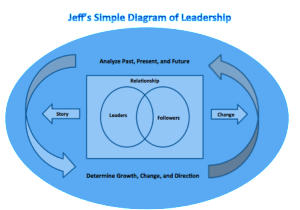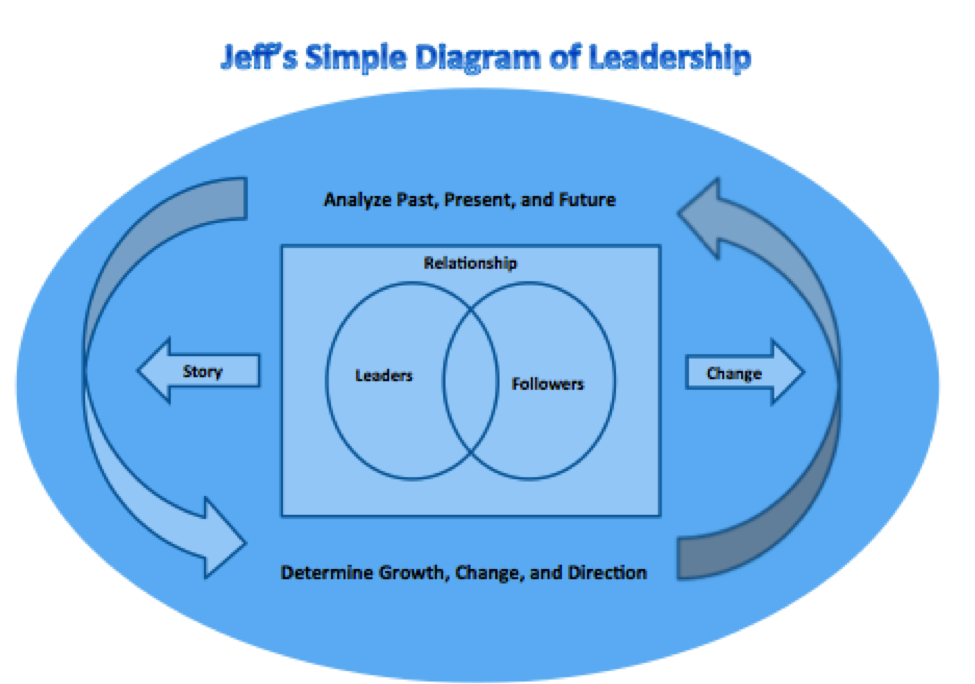My Simple Diagram of Leadership
A number of years ago, in my doctoral studies, I took a course called Issues in Leadership Theory. Throughout the course, we, the students, were assigned essays on various theories, ideas, and characteristics of leadership, with which we were expected to interact and then write reflective responses. The goal was to build a broader understanding of leadership and of the effective practice of leadership.
I was taking this course while serving as the administrator of a K-12 school, one that had experienced some great difficulties and needed to be revitalized. I was on the ground floor, in the middle of leadership activity, trying to build and/or rebuild momentum, enrollment, programs, morale, and even (literally) a school building. There were many issues, needs, and deficiencies that I was wrestling with (like, how to start a hot lunch program, how to expand brand recognition in the community with no advertising budget or director of development, and how to attract new excellent teachers, with a persuasive vision, while retaining the existing excellent teachers who were resistant to change). Although I did not fully realize at the time the extent to which it was happening, I was actually in the process of developing my leadership style and principles of practice. And so, over the duration of that leadership course, as I read, interacted, and responded to the assignments, while at the same time implementing and learning the practical application of those lessons in my job, the ideas that resonated with me began to come together in my mind to form my own personal theory of leadership.
As I put those ideas together in a way that seemed to make sense to me, I began to see leadership as a process that occurs within a context, which I visually illustrate below in a diagram called Jeff’s Simple Diagram of Leadership (I like diagrams and illustrations). The basic concept is this: In any situation, there are leaders and followers. Sometimes who they are can change, but both of the individuals/groups are necessary. The leader must have knowledge of the context/environment in which the leader and followers exist (present). He must also have knowledge of the organizational history (past) and organizational vision (future). With this knowledge, the leader engages in the process that is a continuing cycle of analyzing past, present, and future in order to move people and the organization toward a desired growth, change, or direction.
Now that time has passed since I first formulated these ideas, I believe that this simple diagram is a very accurate picture, and in many ways was even prophetic, of how I have learned to lead. I have come to understand and value the extreme importance of story and culture, both in organizational history and in understanding the people with whom I, as a leader, work, and therefore have learned the value of listening and asking questions (past). I have experienced the importance of the role of relationship in the context and environment in which the leaders and followers interact, and in the process have developed my own relational skills (present). I have learned that I have the ability to see “the big picture” of what the organization ought to be and to communicate this in an understandable way (future). Along the way, I have discovered one of my greatest leadership strengths is the ability to make connections between these three – past, present, and future – in a way that makes sense to people. And now, as I look back, I can see that in each organization in which I have worked, my leadership has followed this pattern and process and has resulted in significant and positive change.
In that particular school in which I was first putting these ideas together, I must admit that I made many mistakes (truth be told, I have made mistakes in every role in which I have worked, but that’s part of the growth process). For example, this is where I learned the importance of taking time to listen to people and understand the culture before initiating change (by making the mistake of making changes too quickly without first understanding the environment). However, I grew in both my knowledge and practice of leadership, resulting in a number of significant positive changes, including, among other things: doubling of enrollment; restoration of financial stability; initiation of a large-scale building program; establishment of a school board, a hot lunch program, an after school program, and a parent-teacher organization; development and expansion of honors and advanced academic programs; and establishment of a student internship program. In a sense, it was a practicing lab in which my particular leadership ability and skills were nurtured and grew.
Since that time in my life, I have further developed effective leadership skills and practices that have enabled me to be an agent of change in several other schools and organizations. I have personally identified many of the basic principles that underscore my approach, which include principles such as: learn history and culture; people matter to God, so it is important to build relationships and care about people; see the big picture; recognize God’s sovereignty; know that to influence change, you have to change the way people think; communicate; empower; serve; be willing to do things differently. Over time, I have also seen my simple diagram of leadership emerge and remain as the crux of my personal theory of leadership, with the three key words of story, relationship, and change reflecting my leadership.
I have found what works well for me, and it involves some fundamental ideas that should be true for every leader, but it also is expressed in a way that matches who I am. I would encourage you to do the same – identify the core leadership principles that matter and learn how to package and use them in a way that best incorporates your strengths so that you can become the best leader you can be, by being yourself.







Leave a Reply
Want to join the discussion?Feel free to contribute!